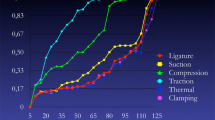Abstract
Purpose
Despite the intrathoracic part being short, the right laryngeal recurrent nerve is often injured during thoracic surgery. The aim of this cadaver study was to understand the mechanisms of right laryngeal recurrent nerve injuries during thoracic surgery and to describe anatomical landmarks for its preservation.
Methods
Dissections were performed on 10 fresh human cadavers. A right anterolateral thoracic wall segment was removed, preserving the first rib. Dissections were carried out to identify the following structures: first rib, esophagus, trachea, right main bronchus, right brachiocephalic and subclavian vessels, azygos vein, phrenic nerve, vagus nerve, and right laryngeal recurrent nerve.
Results
The distance between the origin of the right laryngeal recurrent nerve and its adjacent structures was assessed. Moderate traction of the thoracic part of the vagus nerve resulted in a downward translation of the right laryngeal recurrent nerve’s origin. In such conditions, the right laryngeal recurrent nerve’s origin was distant of 14.8 mm (±2.89 mm) from the subclavian artery.
Conclusions
Intraoperative incidence of right laryngeal recurrent nerve direct injury could be decreased by understanding the detailed course of its intrathoracic part. Moreover, traction on the intrathoracic part of the right vagus nerve may result in indirect lesions of the right laryngeal recurrent nerve: stretch induced lesions and nerve vasculature’s lesions.


Similar content being viewed by others
References
Benouaich V, Marcheix B, Carfagna L et al (2008) Anatomical bases of left recurrent nerve lesions during mediastinoscopy. Surg Radiol Anat 31:295–299
Boone J, Livestro DP, Elias SG et al (2009) International survey on esophageal cancer: part I surgical techniques. Dis Esophagus 22:195–202
Filaire M, Garcier JM, Harouna Y et al (2001) Intrathoracic blood supply of the left vagus and recurrent laryngeal nerves. Surg Radiol Anat 23:249–252
Filaire M, Mom T, Laurent S et al (2001) Vocal cord dysfunction after lung resection for cancer. Eur J Cardiothorac Surg 20:705–711
Gockel I, Kneist W, Keilmann A et al (2005) Recurrent laryngeal nerve paralysis (RLNP) following esophagectomy for carcinoma. Eur J Surg Oncol 31:277–281
Hamdam AL, Moukarbel RV, Farhat F et al (2002) Vocal cord paralysis after open-heart surgery. Eur J Cardiothorac Surg 21:671–674
Itagaki T, Kikura M, Sato S (2007) Incidence and risk factors of postoperative vocal chord paralysis in 987 patients after cardiovascular surgery. Ann Thorac Surg 83:2147–2152
Izbicki JR, Passlick B, Pantel K et al (1998) Effectiveness of radical systematic lymphadenectomy in patients with resectable non-small cell lung cancer: results of a prospective randomized trial. Ann Surg 227:138–144
Lardinois D, De Leyn P, Van Schil P et al (2006) ESTS guidelines for intraoperative lymph node staging in non-small cell lung cancer. Eur J Cardiothorac Surg 30:787–792
Lee MS, Lee UY, Lee JH et al (2009) Relative direction and position of recurrent laryngeal nerve for anatomical configuration. Surg Radiol Anat 31:649–655
Mizutani M, Murakami G, Nawata S et al (2006) Anatomy of right recurrent nerve node: why does early metastasis of esophageal cancer occur in it? Surg Radiol Anat 28:333–338
Mom T, Filaire M, Advenier D et al (2001) Concomitant type I thyroplasty and thoracic operations for lung cancer: preventing respiratory complications associated with vagus or recurrent laryngeal nerve injury. J Thorac Cardiovasc Surg 121:642–648
Monfared A, Kim D, Jaikumar S et al (2001) Microsurgical anatomy of the superior and recurrent laryngeal nerves. Neurosurgery 49:925–932
Mountain CF, Dresler CM (1997) Regional lymph node classification for lung cancer staging. Chest 111:1718–1723
Riquet M (1993) Anatomic basis of lymphatic spread from carcinoma of the lung to the mediastinum: surgical and prognostic implications. Surg Radiol Anat 15:271–277
Riquet M, Manac’h D, Dupont P et al (1994) Anatomic basis of lymphatic spread of lung carcinoma to the mediastinum: anatomo-clinical correlations. Surg Radiol Anat 16:229–238
Scott WJ, Howington J, Feigenberg S et al (2007) Treatment of non-small cell lung cancer stage I and II: ACCP evidence-based clinical practice guidelines (2nd edition). Chest 132:234–242
Swanson SJ, Batirel HF, Bueno R et al (2001) Transthoracic esophagectomy with radical mediastinal and abdominal lymph node dissection and cervical esophagogastrostomy for esophageal carcinoma. Ann Thorac Surg 72:1918–1924
Tang WJ, Sun SQ, Wang XL et al (2011) An applied anatomical study on the recurrent laryngeal nerve and inferior thyroid artery. Surg Radiol Anat [epub ahead of print]
Thomas P, Magnan PE, Moulin G et al (1994) Extended operation for lung cancer invading the superior vena cava. Eur J Cardiothorac Surg 8:177–182
Conflict of interest
The authors declare that they have no conflict of interest.
Author information
Authors and Affiliations
Corresponding author
Rights and permissions
About this article
Cite this article
Benouaich, V., Porterie, J., Bouali, O. et al. Anatomical basis of the risk of injury to the right laryngeal recurrent nerve during thoracic surgery. Surg Radiol Anat 34, 509–512 (2012). https://doi.org/10.1007/s00276-012-0946-7
Received:
Accepted:
Published:
Issue Date:
DOI: https://doi.org/10.1007/s00276-012-0946-7




